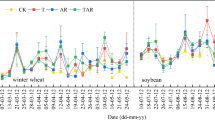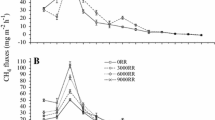Abstract
Field measurements were made from June 2001 to May 2002 to evaluate the effect of crop residue application and temperature on CO2, CH4, and N2O emissions within an entire rice-wheat rotation season. Rapeseed cake and wheat straw were incorporated into the soil at a rate of 2.25 t hm−2 when the rice crop was transplanted in June 2001. Compared with the control, the incorporation of rapeseed cake enhanced the emissions of CO2, CH4, and N2O in the rice-growing season by 12.3%, 252.3%, and 17.5%, respectively, while no further effect was held on the emissions of CO2 and N2O in the following wheatgrowing season. The incorporation of wheat straw enhanced the emissions of CO2 and CH4 by 7.1% and 249.6%, respectively, but reduced the N2O emission by 18.8% in the rice-growing season. Significant reductions of 17.8% for the CO2 and of 12.9% for the N2O emission were observed in the following wheatgrowing season. A positive correlation existed between the emissions of N2O and CO2 (R 2 = 0.445,n = 73,p < 0.001) from the rice-growing season when N2O was emitted. A trade-off relationship between the emissions of CH4 and N2O was found in the rice-growing season. The CH4 emission was significantly correlated with the CO2 emission for the period from rice transplantation to field drainage, but not for the entire rice-growing season. In addition, air temperature was found to regulate the CO2 emissions from the non-waterlogged period over the entire rice-wheat rotation season and the N2O emissions from the nonwaterlogged period of the rice-growing season, which can be quantitatively described by an exponential function. The temperature coefficient (Q 10) was then evaluated to be 2.3±0.2 for the CO2 emission and 3.9±0.4 for the N2O emission, respectively.
Similar content being viewed by others
References
Aulakh, M. S., J. W. Doran, D. T. Walter, A. R. Mosier, and D. D. Francis, 1991: Crop residue type and placement effects on denitrification and materialization.Sool Science Society of America Journal,55, 1020–1025.
Cai, Z. C., G. X. Xing, G. Y. Shen, 1999: Measurement of CH4 and N2O emissions from rice paddies in Fengqiu, China.Soil Science and Plant Nutrition,45(1), 1–13.
Castaldi, S., 2000: Responses of nitrous oxide, dinitrogen and carbon dioxide production and oxygen consumption to temperature in forest and agricultural lighttextured soils determined by model experiment.Biology and Fertility of Soils,32, 67–72.
Chen Wenxin, 1990:Soil and Environmental Microbiology. Beijing Agricultural University Press, Beijing, 304pp. (in Chinese)
Cochran, V. L., E. B. Sparrow, S. F. Schlentner, and C. W. Knight, 1997: Long-term tillage and crop residue management in the subarctic: Fluxes of methane and nitrous oxide.Canadian Journal of Soil Science,77, 565–570.
Davidson, E. A., 1992: Sources of nitric oxide and nitrous oxide following wetting of dry soil.Soil Science Society of America Journal,56, 95–102.
Fang, C., and J. B. Moncrieff, 2001: The dependence of soil CO2 efflux on temperature.Soil Biology & Biochemistry,33, 155–165.
Flessa, H., and F. Beese, 1995: Effect of sugarbeet residues on soil redox potential and nitrous oxide emission.Soil Science Society of America Journal,59, 1044–1051.
Flessa, H., R. Ruser, P. Dörsch, T. Kamp, M. A. Jimenez, J. C. Munch, and F. Beese, 2002: Integrated evaluation of greenhouse gas emissions (CO2, CH4, N2O) from two farming systems in southern Germany.Agriculture, Ecosystems and Environment,91, 175–189.
Huang Yao, Jiang Jingyan, Zong Lianggang, R. L. Sass, and F. M. Fisher, 2001: Comparison of field measurements of CH4 emission from rice cultivation in Nanjing, China and in Texas, USA.Adv. Atmos. Sci.,18(6), 1121–1130.
IPCC, 1996: Impacts, adaptations, and mitigation of climate change: Scientific-technical analysis. Eds.Climate Change: The IPCC Scientific Assessment, R. T. Waston et al., Eds., Cambridge Universtry Press, Cambridge. 745–771.
IPCC, 2001: Atmospheric chemistry and greenhouse gases.Climate Change 2001: The Scientific Basis, Houghton et al., Eds., Cambridge University Press, Cambridge, 248–253.
Larigauderie, A., and C. Körner, 1995: Acclimation of leaf dark respiration to temperature in alpine and lowland plant species.Annals of Botany,76, 245–252.
Lemke, R. L., R. C. Izaurralde, M. Nyborg, and E. D. Solberg, 1999: Tillage and N source influence on soilemitted nitrous oxide in the Alberta Parkland region.Canadian Journal of Soil Science,79, 15–24.
Maljanen, M., P. J. Martikainen, H. Aatlonen, and J. Silvola, 2002: Short-term variation in fluxes of carbon dioxide and methane in cultivated and forested organic boreal soils.Soil Biology & Biochemistry,34, 577–584.
OECD, 2000:Environmental indicators for agriculturemethods and results. Executive Summary 2000, Paris.
Simojoki, A., and A. Jaakkola, 2000: Effect of nitrogen fertilization, cropping and irrigation on soil air composition and nitrous oxide emissions in a loamy clay.European Journal of Soil Science,51(3), 413–424.
Wang Mingxing, 1999:Atmospheric Chemistry. China Meteorological Press, Beijing, 467pp. (in Chinese)
Wang Yuesi, and Wang Yinghong, 2003: Quick measurement of CH4, CO2 and N2O emissions from a shortplant ecosystem.Adv. Atmos. Sci.,20, 842–844.
Xiong, Z. Q., G. X. Xing, H. Tsuruta, G. Y. Shen, S. L. Shi, and L. J. Du, 2002: Field study on nitrous oxide emissions from upland cropping systems in China.Soil Science and Plant Nutrient,48(4), 539–546.
Zheng, X. H., and Coauthors, 1999: Characters of greenhouse gas (CH4, N2O, NO) emissions from croplands of southeast China.World Resource Review,11(2), 229–246.
Zou Jianwen, Jiao Yan, Wang Yuesi, ang Huang Yao, 2002: GC-based technique for determination of CO2, CH4 and N2O emissions from rice paddy.Journal of Nanjing Agricultural University,25(4), 45–48. (in Chinese)
Zou Jianwen, Huang Yao, Zong Lianggang, Jiang Jingyan, Zheng Xunhua, and Wang Yuesi, 2003: Effects of water regime and straw application in paddy rice season on N2O emission from following wheat growing season.Agricultural Sciences in China,2(1), 68–74.
Author information
Authors and Affiliations
Rights and permissions
About this article
Cite this article
Jianwen, Z., Yao, H., Lianggang, Z. et al. Carbon dioxide, methane, and nitrous oxide emissions from a rice-wheat rotation as affected by crop residue incorporation and temperature. Adv. Atmos. Sci. 21, 691–698 (2004). https://doi.org/10.1007/BF02916366
Received:
Revised:
Issue Date:
DOI: https://doi.org/10.1007/BF02916366




